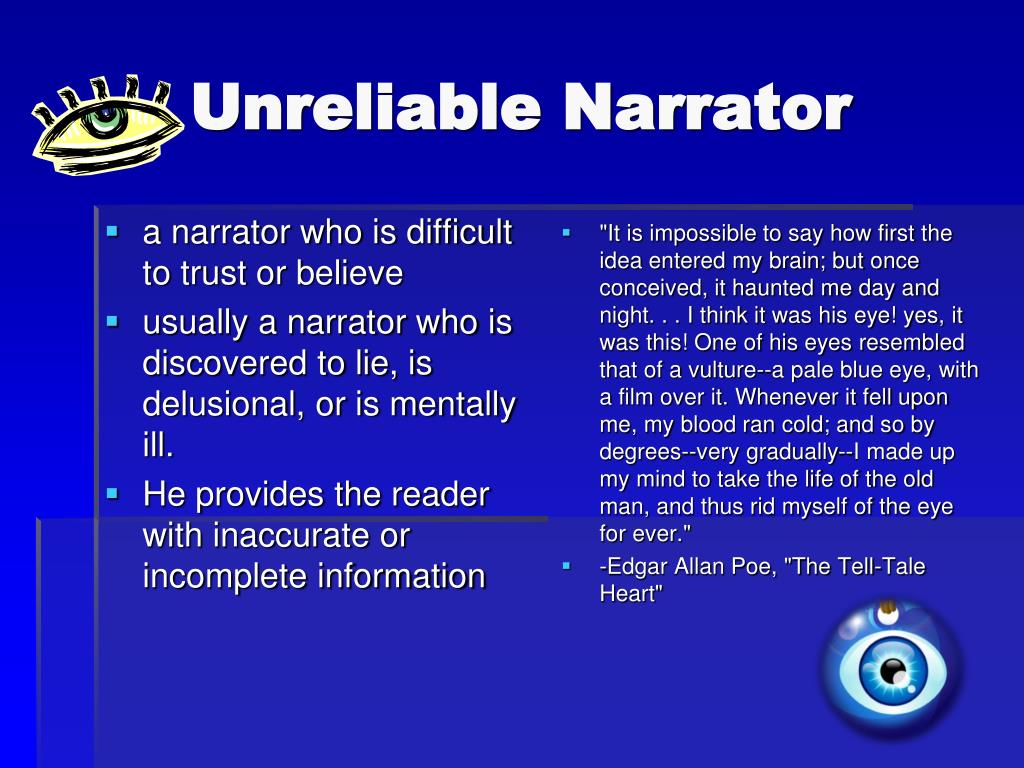
In most fiction, the main character telling the story is a reliable narrator – readers can trust the version of events being provided is an accurate representation of that universe’s reality. Here’s what you need to know about telling your audience lies for fun. They can be subversive, tragic, hilarious, or downright villainous, and they’re a great way to give your audience something to enjoy on a re-read. Unreliable narrators are some of the most fun an author can have with their audience’s expectations. With a defense like that, we immediately know that we can’t trust this man. It hits like a ton of bricks - we’re watching a madman defend the murder of his employer based on the idea that, in his head, he was morally right. But you should have seen me…I was never kinder to the old man than during the whole week before I killed him.” And if you’d like help with or feedback on any aspect of your writing, our expert editors are available 24/7.One of my favorite openings to any story is from the third paragraph of Edgar Allan Poe’s The Tell-Tale Heart: However you use it, though, unreliable narrative voices are a powerful tool in the writer’s kit. Set up a mystery or plot twist based on the narrator’s unreliability.Influence who the reader sympathises with in the story.Give the reader insight into how the narrator views the world.Create tension and make the reader question what they are being told.You can use an unreliable narrator for various ends, including to: Amy and Nick from Gone Girl by Gillian Flynn, who set out different versions of the same events throughout the story.Adrian Healey from The Liar by Stephen Fry, in which the narrator eventually reveals that many of the events described are entirely untrue.Humbert Humbert from Vladimir Nabokov’s Lolita, in which the narrator tries to appear sympathetic rather than abusive.Other famous unreliable narrators include: His ‘unreliability’ as a narrator is therefore a key element of his character and the themes of the novel. He even admits he is a liar, prone to exaggeration, and frequently confused about details of his story. But as the story goes on, the reader finds out that he is not always trustworthy. Throughout the novel, he accuses many people of being ‘phony’. One of the most famous examples of an unreliable narrator in fiction is Holden Caulfield, the protagonist and narrator of J.D. Thank you for subscribing to our newsletter! Or it could be revealed dramatically in a plot twist. if the narrator introduces subtle inconsistencies). Alternatively, it could slowly become apparent as the story progresses (e.g. if they make obviously untrue statements early on). The narrator’s unreliability might be obvious from the start (e.g. when the story is told from one character’s point of view and reflects their limited understanding or biases). This is most common with limited, first-person narrators (e.g. We call a narrative voice ‘unreliable’ if it seems untrustworthy because the narrator is dishonest, misinformed, or even deluded. As such, we will now look at unreliable narrative voices in more detail, including how they work and when you might want to use one in your own writing. It is the last of these that interests us most here. a story in which we might not entirely trust what the narrator is telling us). a story in which the narrator presents a straightforward, credible account of events) or unreliable (i.e. where the narrator knows everything in the world of the story). the story is told from a specific point of view, so the reader only knows what the narrator knows) or omniscient (i.e. Various things influence how narrative voice works, including: This can affect how the reader relates to the narrator, other characters, and the story as a whole. the character or person telling a story).

The term ‘narrative voice’ refers to the perspective from which a story is told (i.e.

But what is narrative voice? And what does it mean to have an unreliable narrator? In this post, we explain the basics of reliable and unreliable narrative voices.

The narrative voice is a key aspect of any work of fiction.


 0 kommentar(er)
0 kommentar(er)
